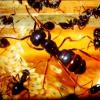Korean name : 가시개미 (Ga-si-gae-me)
Scientific name : Polyrhachis lamellidens
Polyrhachis lamellidens is parasitic on Camponotus sp..
So Korean ant keeper have been using 'One to one parasitization'
<Process of 'One to one parasitization'>
1.Collect Polyrhachis lamellidens queen, Camponotus colony.
*It doesn't matter if the Camponotus colony don't have the queen.
2.Get one woker from Camponotus colony.
*The smaller worker is the better.
3.Put a Camponotus worker and Polyrhachis queen in a small case.
4.Put 3~5 additory Camponotus workers after one day or two days.
5.Repeat 'Process No.4' two or three times.
6.Put Polyrhachis queen and Camponotus workers to Camponotus colony.
7.Wait for the queen produce eggs
But this process have been making many failures, and I devise diffirent process.
Somebody call my parasitization process 'Inverse concept parasitization'.
<Process of 'Inverse concept parasitization'>
1.Collect Polyrhachis queen, Camponotus colony
*The colony must have a queen.
2.Get a queen from Camponotus colony.
3.Put Polyrhachis queen and Camponotus queen in a small case.
4.Put 20~50 additory Camponotus workers after half day.
5.Put Polyrhachis queen and Camponotus workers to Camponotus colony after one or two day.
'Inverse concept parasitization' is faster, more powerful than 'One to one parasitization', and we can sucess to put more Polyrhachis queen.
I succeeded to put 40 Polyrhachis lamellidens queens to Camponotus atrox(Someone s in this year and my queens are producing many eggs now.
I think the difference of two process is the difference of cast pheromone of the host that they encounter at the beginning.
You can see pictures of Polyrhachis lamellidnes's parasitization on my blog.
http://blog.naver.co...us/220163701646
-----------------------------------------------------------------------------------------------------------------------------------
I hope to know about parasitic ants of the other countries!! ![]()
Edited by GAEME, December 10 2014 - 1:48 AM.
























